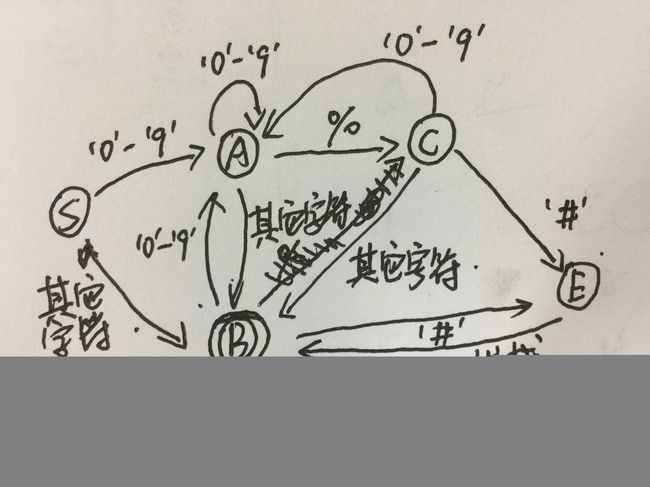2019年Byte Camp夏令营5月25日笔试题解
笔试题共有4题编程题,前3题较为简单,本文给出相应的思路和解答。
第1题
题目大意:给出n个景点,每个景点有相应的分值 a 1 , a 2 , . . . , a n a_1, a_2, ..., a_n a1,a2,...,an。小明一天之内要游玩两个景点 i , j i, j i,j,景点之间的距离为下标之差的绝对值 ∣ i − j ∣ |i-j| ∣i−j∣,满意度为景点的分值之和减去景点之间的距离,公式为 a i + a j + i − j , ( j > i ) a_i+a_j+i-j, (j>i) ai+aj+i−j,(j>i)。要求为小明选出两个景点,给出最大的满意度。
输入:共两行。第一行为n,表示有n个景点;第二行按序给出每个景点的分值。
输出:输出最大的满意度。
解题思路:本题很简单,使用两个for循环即可,但是时间复杂度为 O ( n 2 ) O(n^2) O(n2)。本人就使用此方法解题,但是由于时间复杂度太高,只通过了60%的测试用例。大致代码如下:
public class Solution {
...
public static int handler(int[] arr) {
int max = 0;
for (int i = 0; i < arr.length; ++i) {
for (int j = i + 1; j < arr.length; ++j) {
int temp = arr[i] + arr[j] + i - j;
max = max >= temp ? max : temp;
}
}
return max;
}
}
后来尝试使用 O ( n l o g n ) O(nlogn) O(nlogn)的时间复杂度,但是没有想到合适的办法。在笔试结束后,突然对有了领悟: a i + a j + i − j = ( a i + i ) + ( a j − j ) , ( j > i ) a_i+a_j+i-j = (a_i + i) + (a_j - j), (j>i) ai+aj+i−j=(ai+i)+(aj−j),(j>i)。细看此式,有点类似于求一个数组中两个数的最大和,因此 O ( n ) O(n) O(n)的复杂度即可解决此问题:
import java.util.Scanner;
public class Solution {
punlic static void main(String[] args) {
Scanner sc = new Scanner(System.in);
int n = sc.nextInt();
int[] arr = new int[n];
for (int i = 0; i < n; i++) {
arr[i] = sc.nextInt();
}
System.out.println(handler(arr));
}
public static int handler(int[] arr) {
if (arr == null || arr.length == 0) return 0;
// maxI保存当前arr[i]+i最大的值
int maxI = arr[0];
// max保存当前最大的满意度,即arr[i]+i+arr[j]-j最大
int max = 0;
for (int i = 1; i < arr.length; ++i) {
max = max >= maxI + arr[i] - i ? max : maxI + arr[i] - i;
maxI = maxI >= arr[i] + i ? max : arr[i] + i;
}
return max;
}
}
第2题
题目大意:给出一个二维数组,数组中元素的值为1或0。要求找出数组中的块数,每一块由任意个相连的1组成,相连规则:当前元素为1,且其上、下、左、右、左上、左下、右上、右下,只要这8个位置任意一个位置中元素为1,则当前元素与此元素相连。
输入:第一行为m、n,m代表数组行数,n代表数组列数。此后为m*n行,代表要二维数组。
输出:数组中的块数。
示例:
输入:
3 3
0 1 0
1 0 0
1 0 1
输出:2(右下角的1独自成一块,其余三个1相连成一块)
解题思路:扫描二维数组,每次遇到值为1的元素,就对其所在的块进行处理。处理过程,将当前元素置0,并判断其相邻的8个位置是否为1,如果为1则对其进行相同处理,如果为0则不处理。
import java.util.Scanner;
public class Solution {
pulic static void main(String[] args) {
Scanner sc = new Scanner(System.in);
int m = sc.nextInt();
int n = sc.nmextInt();
int[] arr = new int[m][n];
for (int i = 0; i < m; ++i) {
for (int j = 0; j < n; ++j)
arr[i][j] = sc.nextInt();
}
int num = findBlockNum(arr);
System.out.println(num);
}
public static int findBlockNum(int[][] arr) {
if (arr == null || arr.length == 0) return 0;
int m = arr.length;
int n = arr[0].length;
// 保存块数
int num = 0;
// 遍历数组中的每一个元素
for (int i = 0; i < m; ++i) {
for (int j = 0; j < n; ++j) {
if (arr[i][j] == 1) {
// 将整个块找出来
exploreBlock(arr, i, j);
++num;
}
}
}
return num;
}
public static void exploreBlock(int[][] arr, int i, int j) {
if (arr == null || arr.length == 0) return;
// 边界情况
if (i >= arr.legnth || i < 0) return;
if (j >= arr[0].length || j < 0) return;
// 先将当前位置的1置0
// 置0的好处:
// 1. 当对其相邻为1的元素进行同样处理时,不会再次处理当前位置,
// 避免陷入循环调用,造成栈溢出
// 2. 当前位置置0,避免findBlock函数中的循环再次对元素进行处理
arr[i][j] = 0;
explore(arr, i-1, j-1);
explore(arr, i-1, j);
explore(arr, i-1, j+1);
explore(arr, i, j-1);
explore(arr, i, j+1);
explore(arr, i+1, j-1);
explore(arr, i+1, j);
explore(arr, i+1, j+1);
return;
}
}
上述代码在运行时只通过了80%的测试用例。据说是因为使用太多递归调用,在处理较大的数组时,导致栈溢出。因此,可以将递归调用改成while循环和列表。
import java.util.Scanner;
import java.util.ArrayList;
pulic class Solutin {
public class Point {
public int i, j;
public Point(int i, int j) {
this.i = i;
this.j = j;
}
}
// main等函数和上面一样,此处省略
...
public static void exploreBlock(int[][] arr, int i, int j) {
List<Point> list = new ArrayList<Point>;
list.add(new Point(i, j));
Point tempP;
while (list.size() > 0) {
tempP = list.get(0);
list.remove(0);
arr[tempP.i][tempP.j] = 0;
checkPoint(arr, tempP.i-1, tempP.j-1, list);
checkPoint(arr, tempP.i-1, tempP.j, list);
checkPoint(arr, tempP.i-1, tempP.j+1, list);
checkPoint(arr, tempP.i, tempP.j-1, list);
checkPoint(arr, tempP.i, tempP.j+1, list);
checkPoint(arr, tempP.i+1, tempP.j-1, list);
checkPoint(arr, tempP.i+1, tempP.j, list);
checkPoint(arr, tempP.i+1, tempP.j+1, list);
}
return;
}
public static void checkPoint(int[][] arr, int i, int j, List<Point> list) {
if (arr == null || arr.length == 0) return;
// 边界情况
if (i >= arr.legnth || i < 0) return;
if (j >= arr[0].length || j < 0) return;
if (arr[i][j] == 1) list.add(new Point(i, j));
return;
}
}
第3题
题目大意:给出一个字符串,要求将%到#之间的字符串复制n次,n为%之前的数字。%#可嵌套。
输入:一行字符串
输出:处理后的字符串
示例:
输入:2%g3%n##
输出:gnnngnnn
解题思路:对于%#可嵌套的问题可用栈进行解决。先入栈的后处理,后入栈的先处理。至于如何识别数字、符号%和#以及要复制的字符串,可用自动机来处理。

维护一个全局变量string,表示最终的字符串。
对于上图,从起始状态S开始,依次读取字符串中的字符。如果当前字符是’0’-‘9’,则转到状态A,状态A对数字进行处理;如果是其它字符,则转为状态B,状态B对字符串进行拼接。
状态A维护一个字符串tempA,拼接数字字符。从A出发,如果当前字符是’0’-‘9’,则状态A继续接收,如果是’%’,则表明这是一个复制操作,如果当前栈中所保存的’%‘不为0,则表明这同时是一个嵌套的复制操作,将tempC压入栈中,并将tempC置空,转到状态C,同时并将tempA压入栈中,将当前栈中所保存的操作个数+1,表示要复制的操作嵌套的个数;如果是其它字符,则表明此前读取的数字都是普通字符串,不代表复制的倍数,转到状态B,并将tempA清空。
对于状态C,如果当前字符为’#’,则表示’%‘到’#‘之间的字符串个数为0,压入一个空字符串进栈,转到状态E;如果当前字符是其它字符,则维护一个字符串tempC,转到状态B。
对于状态E,如果当前栈中所保存的操作个数不为0,则从栈中弹出两个元素,依次为:要复制的元素、复制的次数。将字符串复制之后给tempE,如果当前栈中所保存的操作个数为0,即栈空,则将tempE保存到string中,否则弹出栈中的栈顶字符串,保存到tempC中,转到状态B。
对于状态B,如果当前字符是’0’-‘9’,转到状态A;如果是其它字符,则判断当前栈中所保存的操作个数,如果不为0,则保存到tempC中,表明这个字符属于要复制的字符串,否则就将它保存到string中;如果当前字符是’#’,则判断当前栈中所保存的草走个数,如果为0,表示这不是一个复制操作的结尾,将其放入string中,否则将tempC压入栈中,转到状态E。
package testing;
import java.util.Scanner;
import java.util.Stack;
public class Solution {
public static void main(String[] args) {
Scanner sc = new Scanner(System.in);
String input = sc.nextLine();
input = handler(input);
System.out.println(input);
}
public static String handler(String s) {
if (s == null || s.length() <= 3) return s;
Stack<String> stack = new Stack<String>();
String string = "", numStr = "", tempC = "";
int operNum = 0;
for (int i = 0; i < s.length(); ++i) {
// 当前字符是数字
if (s.charAt(i) > '0' && s.charAt(i) < '9') {
// 当前栈中操作数不为零,则可能是嵌套,先将tempC压栈保存
if (operNum > 0) {
stack.push(tempC);
tempC = "";
}
numStr += s.charAt(i);
}
else if (s.charAt(i) == '%') {
// 判断numStr是否为空,如果不为空,则认为是复制操作
if (!numStr.equals("")) {
stack.push(numStr);
numStr = "";
++operNum;
}
// 否则,"%"只是普通字符
else {
if (operNum > 0)
tempC += "%";
else
string += "%";
}
}
else if (s.charAt(i) == '#') {
// 判断栈中操作数
if (operNum > 0) {
// 将要复制的字符串tempC压入栈中
if (stack.size() % 2 == 0) {
tempC = stack.pop() + numStr + tempC;
numStr = "";
}
stack.push(tempC);
tempC = "";
String temp = copyString(stack);
--operNum;
// 如果操作数不为0,弹出栈中要复制的字符串
if (operNum > 0) {
tempC = stack.pop();
tempC += temp;
} else {
string += temp;
}
} else {
string += numStr;
numStr = "";
string += "#";
}
}
// 其他字符
else {
// 此处要处理状态A到状态B的情况
// 即numStr中的数字只是普通字符
if (operNum > 0) {
tempC += numStr;
tempC += s.charAt(i);
}
else {
string += numStr;
string += s.charAt(i);
}
numStr = "";
}
}
return string;
}
public static String copyString(Stack<String> stack) {
if (stack == null || stack.isEmpty()) return "";
String s = stack.pop();
int times = Integer.valueOf(stack.pop());
String temp = s;
while (times > 1) {
s += temp;
--times;
}
return s;
}
}
上述代码测试用例通过率100%,但不能保证完全没问题。
以上几题题解供大家参考,欢迎大家指正!